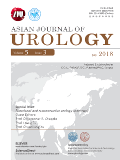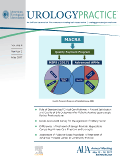
Urology Journal
Scope & Guideline
Unlocking insights in urology, one study at a time.
Introduction
Aims and Scopes
- Clinical Urology and Patient Outcomes:
Research that explores the effectiveness of various treatments and interventions in urology, including surgical techniques, pharmacological therapies, and innovative technologies. - Neurourology and Urodynamics:
Studies focusing on the neurological aspects of bladder function, including the effects of nerve stimulation and neuroanatomical changes on urinary function. - Innovative Technologies in Urology:
Research on the application of advanced technologies such as artificial intelligence, virtual reality, and imaging techniques to enhance diagnostic and therapeutic approaches in urology. - Bladder and Prostate Disorders:
Investigation into conditions affecting the bladder and prostate, including interstitial cystitis, benign prostatic hyperplasia, and overactive bladder, with an emphasis on understanding pathophysiology and treatment options. - Psychosocial Factors in Urology:
Exploration of the psychological and social dimensions of urological conditions, including the impact of anxiety and stress on urinary health.
Trending and Emerging
- Artificial Intelligence and Machine Learning:
A growing emphasis on the use of AI and machine learning techniques for diagnosis, treatment planning, and patient monitoring in urology, reflecting a broader trend in healthcare towards digital transformation. - Interdisciplinary Approaches to Urological Disorders:
Research that integrates insights from other fields, such as psychology, nutrition, and genetics, is increasingly prominent, highlighting the complex interplay between various factors in urological health. - Patient-Centered Care and Quality of Life Studies:
There is a rising focus on research that evaluates patient-reported outcomes and quality of life, particularly in the context of chronic urological conditions, as healthcare shifts towards more holistic approaches to treatment. - Innovations in Urodynamic Assessment and Therapy:
Emerging studies on advanced urodynamic testing methods and therapies, including neuromodulation and novel drug delivery systems, are gaining traction, indicating a shift towards more precise and effective management of urinary disorders.
Declining or Waning
- Traditional Surgical Techniques:
There has been a noticeable decrease in research focused on conventional surgical procedures, possibly due to the increasing interest in minimally invasive techniques and robotic surgery. - Basic Science Research without Clinical Relevance:
Studies that delve into basic science without direct clinical applications or implications are becoming less frequent, as the journal appears to emphasize translational research that bridges laboratory findings with clinical practice. - Pharmacological Studies on Established Drugs:
Research examining the efficacy of long-established medications in urology is less common, indicating a potential shift towards exploring novel therapies and drug development.
Similar Journals

PROGRES EN UROLOGIE
Leading the Charge in Urological AdvancementsPROGRES EN UROLOGIE is a renowned academic journal published by Elsevier Masson, Corp Off that focuses on the dynamic field of urology. With an ISSN of 1166-7087 and an E-ISSN of 2405-5131, this journal has been contributing to the scientific community since its inception in 1991 and continues to disseminate valuable research findings to urologists and medical professionals. As of 2023, it holds a distinguished position within the Q3 category in Urology, reflecting its commitment to publishing high-quality and impactful research—ranked 74th out of 120 in the Scopus Urology category, placing it in the 38th percentile. While it does not currently offer open access options, the journal remains an essential resource for researchers seeking to advance their understanding of the latest urological practices and innovations. Its contributions are vital in a rapidly evolving medical landscape, ensuring that both established and emerging issues in urology are thoroughly explored and discussed.

Asian Journal of Urology
Elevating the discourse in urological sciences.Asian Journal of Urology is a premier open-access scholarly journal dedicated to advancing the field of urology. Published by Elsevier Singapore Pte Ltd, this journal provides a platform for researchers, clinicians, and students to share impactful findings and innovative practices within urological sciences. Since its inception in 2014, it has established itself as a significant contributor to the discourse in urology, achieving a commendable Q2 ranking in the category of Urology for 2023 and securing the 41st position out of 120 in Scopus rankings, placing it in the 66th percentile amongst its peers. With a commitment to ensuring broad accessibility, all articles are freely available online, promoting widespread dissemination of knowledge. The journal aims to publish high-quality research that informs clinical practices and contributes to the development of urological sciences, making it an essential resource for professionals and scholars in the field.

Urology Research and Practice
Transforming insights into impactful urological practices.Urology Research and Practice, published by AVES in Turkey, is an essential open-access journal dedicated to advancing the field of urology. With its inaugural issues released in 2023, the journal aims to disseminate cutting-edge research, innovative practices, and insightful clinical studies pertinent to urology, thereby fostering knowledge and collaboration among researchers, healthcare professionals, and students alike. Currently indexed in Scopus, it ranks Q3 in the urology category, reflecting its growing impact evidenced by a 47th percentile ranking in the Medicine Urology field. The journal not only serves as a platform for exceptional scholarly work but also emphasizes accessibility and inclusivity in scientific communication, allowing for a broader dissemination of urological knowledge globally. Explore groundbreaking research and contribute to the evolving landscape of urology through Urology Research and Practice.

Actas Urologicas Espanolas
Advancing Urological Knowledge Since 1977Actas Urologicas Espanolas is a prestigious journal published by Elsevier España, dedicated to the field of Urology. Established in 1977, this journal has significantly contributed to advancing knowledge and research in urological medicine and surgery, spanning a comprehensive scope that includes clinical studies, surgical techniques, and the latest innovations in the treatment of urological diseases. With an impact factor reflecting its critical role in the academic community, it is ranked Q3 in the Urology category as of 2023, placing it amongst the valuable resources for professionals and researchers. The journal is indexed under Scopus, achieving a commendable rank of #70 out of 120 in the Medicine-Urology category, situating it within the 42nd percentile. As a significant platform for sharing advancements and findings, it encourages submissions that enhance urological care and improve patient outcomes. Although not an Open Access journal, the publication remains vital for those looking to stay updated on the latest developments in urology. For more details, visit their office located at CALLE DE ZURBANO, 76-4TH FLR LEFT, MADRID, 28010, SPAIN.

Urology Practice
Connecting academia and practice in urological medicine.Urology Practice is a distinguished journal dedicated to advancing knowledge and practice in the field of urology. Published by Lippincott Williams & Wilkins, this journal has been pivotal in providing a platform for the dissemination of innovative research and clinical findings since its inception in 2014. With an ISSN of 2352-0779 and an E-ISSN of 2352-0787, the journal is indexed in Scopus, ranking #73 out of 120 in the Urology category, placing it in the 39th percentile. As part of the Q3 quartile in Urology for 2023, Urology Practice contributes significantly to the evolving landscape of urological medicine, offering vital insights to researchers, healthcare professionals, and students alike. While currently not an open-access journal, its valuable content remains accessible through traditional subscription-based models, catering to a global audience keen on enhancing their expertise in urology. The journal's commitment to excellence and its rigorous peer-review process ensure that published articles uphold the highest standards of scientific integrity, making it an essential resource for those engaged in urological research and clinical practice.

Journal of Pediatric Urology
Fostering collaboration to enhance pediatric urological care.Journal of Pediatric Urology is a leading academic journal dedicated to the intersection of pediatric medicine and urological science. Published by ELSEVIER SCI LTD, this esteemed journal provides a vital platform for the dissemination of innovative research and clinical advancements in the field. With a 2023 impact factor that places it within the Q2 quartile for Pediatrics, Perinatology and Child Health, and the Q1 quartile for Urology, it is recognized among the top-tier journals in both domains. The journal covers a broad spectrum of topics from minimally invasive surgical techniques to management strategies for congenital urological disorders. This makes it an invaluable resource for researchers, clinicians, and students who seek to improve pediatric urological care. As the journal continues to evolve, it aims to foster interdisciplinary collaboration that drives further advancements in pediatric health. For those looking to avoid publication barriers, the journal retains traditional access options while contributing to the global growth of pediatric urology research from its base in the Netherlands.

EUROPEAN UROLOGY
Leading the way in urological innovation and excellence.EUROPEAN UROLOGY is a prestigious journal in the field of urology, published by Elsevier, and residing in the vibrant academic landscape of the Netherlands. Since its inception in 1975, the journal has made significant contributions to urological research, earning a top rank of #1 out of 120 in the Scopus category of Medicine - Urology, placing it within the esteemed 99th percentile of its field. With a commitment to disseminating cutting-edge research, clinical findings, and innovative practices, EUROPEAN UROLOGY has established itself as a pivotal resource for urologists and researchers alike. Although it does not offer open access options, it provides an indispensable platform for scholarly communication that drives advancements in patient care and medical knowledge. As the journal embarks on converged years leading up to 2024, it continues to strive for excellence in urology, welcoming contributions that reflect the latest scientific advancements and clinical applications.

European Urology Oncology
Elevating the standards of urological oncology research.European Urology Oncology is a premier academic journal dedicated to advancing the field of urological oncology through innovative research and interdisciplinary collaboration. Published by Elsevier and based in the Netherlands, this journal runs on the principles of providing high-quality, peer-reviewed content that meets the evolving needs of professionals in medicine, surgery, and oncology. With an impressive 2023 categorization in the Q1 quartiles across multiple disciplines including Medicine (Miscellaneous), Oncology, and Urology, the journal demonstrates its pivotal role in disseminating essential findings that enhance clinical practices. The E-ISSN of this journal is 2588-9311, ensuring accessibility to groundbreaking articles that influence treatment methodologies and patient outcomes. Researchers and professionals relying on the latest evidence in urology and oncology will find this journal essential for keeping abreast of cutting-edge developments and clinical insights that shape the future of healthcare.

UROLOGIC CLINICS OF NORTH AMERICA
Shaping the future of urology through rigorous scholarship.Urologic Clinics of North America is a prestigious journal published by W B Saunders Co-Elsevier Inc, dedicated to advancing the field of urology through high-quality, peer-reviewed articles. Since its inception in 1974, this journal has become an essential resource for urologists and researchers, providing insightful clinical reviews, the latest research findings, and practical guidelines for best practices in urological care. With an impressive 2023 category quartile of Q2 in Urology and a commendable Scopus ranking of 34 out of 120 in the Medicine-Urology category, it consistently ranks in the 72nd percentile among its peers. While the journal does not currently offer open access, it remains a critical platform for disseminating significant advancements in the field and fostering professional development. As the journal approaches its 50th year, its enduring commitment to enriching the knowledge base of urology continues to make it a favored publication for both established professionals and students alike.

WORLD JOURNAL OF UROLOGY
Advancing Urological Science with ExcellenceWORLD JOURNAL OF UROLOGY, published by Springer, stands as a premier journal in the field of urology, holding a commendable Q1 ranking in the 2023 category quartiles. With an ISSN of 0724-4983 and an E-ISSN of 1433-8726, this journal has been a vital resource since its inception in 1983, and continues to influence research up to 2024. Its ranking of 13th out of 120 in the Scopus Medicine Urology category, placing it in the 89th percentile, reflects its significant impact within the academic community. The journal aims to publish cutting-edge research, reviews, and clinical studies that advance knowledge in urological science and practice. Although it features no open access options, its rigorous peer-review process ensures that only the highest quality studies are disseminated, catering to a wide audience of researchers, medical professionals, and students eager to stay at the forefront of urological advancements.